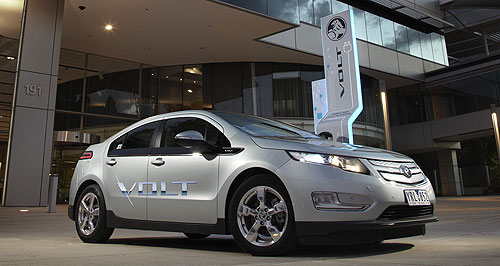Make / Model Search
News - General News - Electric VehiclesOvernight EV charging means no coal CO2: HoldenNo impact: According to Holden, coal-fired power stations generate enough excess energy at night to charge thousands of electric cars. Holden claims charging EVs from coal-fired power overnight has no CO2 impact14 Sep 2012 GM HOLDEN has joined the chorus of car-makers refuting claims that charging electric vehicles from traditional coal-fired power stations means their carbon-dioxide emissions are just as bad as equivalent internal-combustion cars. Speaking at a media briefing for the new Volt range-extender EV, Holden energy and environment director Richard Marshall said there is enough excess overnight electricity generation capacity in Australia for “many thousands” of EVs to be charged without adding increasing CO2 output from power stations. Criticism has been levelled at charging EVs in Victoria, where three major power stations burn brown coal to generate electricity, which is widely regarded as one of the most polluting ways doing so. Mr Marshall described these power stations as “massive machines that run 24/7” and explained that to shut them down and bring them back up to speed “takes between half a day to three days”. “What this means is that when you are charging your vehicle overnight in particular there is a significant amount of spinning reserve that is already sitting there, where the coal is still being churned through – so you are not really adding any additional load to the system and so you are not adding any additional CO2 by using that power,” he said.  Left: Holden's Richard Marshall. Left: Holden's Richard Marshall.“We are not sure exactly how many cars you can add before you start to increase that minimum load but if you look at it in broad terms, that is why we have street lights on, that is why we have off-peak water heaters to soak up some of that load that has been generated... what they generate has to be used somewhere. “So there is this reserve capacity, many thousands of cars worth that you can plug in without adding any extra to the load, so there is no issue with plugging in EVs overnight in Victoria because it is not really adding to the load at all.” The Volt, which will reach Australian showrooms in November, has several charging modes including a timer that can be programmed to use only off-peak energy to save cost and CO2 emissions. Holden’s EV infrastructure partner for Volt customers, Better Place, and the provider of charging devices at its Melbourne headquarters, ChargePoint, both provide only certified ‘green energy’ by ensuring the equivalent energy used charging vehicles is generated using renewable sources like hydro, solar and wind. Several car-makers – including Holden – argue that customers willing to pay a premium for the early adoption of electric vehicles are also likely to pay extra for renewable energy for their home or business. Holden says the Volt can travel for up to 87 kilometres on electricity alone, before a 1.4-litre petrol engine kicks in to generate electricity – but is not directly connected to the wheels. The petrol engine operates at a fixed RPM depending on how much power is required but diesel engines tend to be more fuel-efficient when used in this way. Mr Marshall told GoAuto the reasons for using petrol rather than diesel to generate electricity were reliability, cost and weight. “We could have gone with a diesel engine but a diesel is a lot heavier, with a cast-iron block compared to an alloy block and it is more expensive,” he said. “By and large the whole point of this is that the petrol engine is there to ease range anxiety.” Mr Marshall explained that the purpose of the Volt is to spend the majority of its time running on electricity, with the generator as a back-up to eliminate range anxiety and make the car a realistic proposition for occasional long journeys. However he said there may be more efficient solutions for running with the generator on in the longer term. Although the Volt’s sticker price of $59,990 plus on-roads is high for a small car not bearing a premium European badge, like other electric cars it makes a case for itself with low running costs compared with an internal combustion equivalent. Mr Marshall claimed the Volt’s electricity consumption over a year, based on overnight charging and driving around 80km per day (between 15,000 and 20,000 kilometres per year), is 25MWh – equivalent to a fridge-freezer or water heater, with each full charge costing around $2.50. “A computer and monitor being switched on all day is equivalent to driving 80 kilometres”, he said. In addition, under Holden’s capped-price servicing scheme, the Volt costs $185 per workshop visit – equivalent to the Barina Spark city car, Barina light car and petrol versions of the Cruze small car. Like other EVs and most hybrids, the Volt’s brake consumables like pads and rotors do not require such frequent replacement due to the strong deceleration from its regenerative braking system. “You can drive the car virtually completely in regen mode where you would barely touch your friction brakes,” said Mr Marshall, who also pointed out the potential longevity of electric vehicles compared with those powered by internal combustion engines. “The great thing about these electric machines is that you don’t have any moving parts of any significance and apart from bearings there are no other things touching each other. “The battery is designed to last the life of the vehicle... we don’t really specify a life for the vehicle but in the same way you don’t really expect to change an engine an so-on during the life of a car.” General Motors provides an eight-year warranty on the Volt’s battery but the suggestion among Holden staff at the briefing was that its useful life could extend well beyond that and Mr Marshall said the warranty was there to give customers “additional certainty” because it is “early days” in the commercialisation of EVs. He explained the Volt has a battery management system that ensures it is never 100 per cent charged or completely empty and keeps its temperature within an optimum operating range, meaning it is less susceptible to degradation.  Read more |
Click to shareGeneral News articlesResearch General News Motor industry news |











Facebook Twitter Instagram